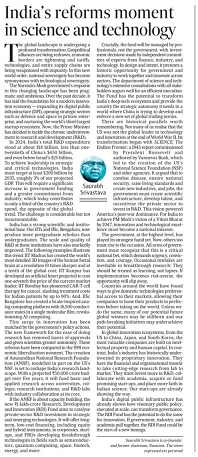India’s reforms moment in Science and Technology
Click here to read full article on Hindustan Times
In 2024, India’s total R&D expenditure stood at about $18 billion, less than one-twentieth of China’s $450 billion, and even below Israel’s $25 billion. To achieve leadership in strategic and critical technologies, India must target at least $200 billion by 2035, roughly 3% of our projected GDP. This will require a significant increase in government funding and a greater commitment from industry, which today contributes to only a third of the country’s R&D spend, the opposite of the global trend. The challenge is considerable but not insurmountable.
India has a strong scientific and institutional base. Our IITs and IISc, Bengaluru, now produce more postgraduate scholars than undergraduates. The scale and quality of R&D at these institutions have also markedly improved. The following examples illustrate this trend: IIT Madras has created the world’s most detailed 3D images of the human foetal brain at a resolution 10 times sharper and at a tenth of the global cost; IIT Kanpur has developed an artificial heart projected to cost one-seventh the price of the current market leader; IIT Bombay has pioneered CAR-T cell therapy for cancer, slashing treatment costs for Indian patients by up to 90%; And, IISc Bangalore has created a brain-inspired analog computing platform with 16,500 conductance states in a single molecular film, revolutionising AI computing.
This surge in innovation has been matched by the government’s policy actions. The new framework for the ease of doing research has removed layers of approvals and given scientists greater autonomy. These reforms have been compared to the 1991 economic liberalisation moment. The creation of Anusandhan National Research Foundation (ANRF), modelled in part on the US’s NSF, is set to reshape India’s research landscape. With a projected ₹50,000 crore budget over five years, it will fund basic and applied research across universities, colleges, research institutions, and R&D labs with industry collaboration at its core.
If the ANRF is about capacity building, the new ₹1-lakh-crore Research, Development and Innovation (RDI) Fund aims to catalyse private-sector R&D investment in strategic and emerging technologies. It will offer long-term, low-cost financing, including equity and hybrid instruments, to corporates, start-ups, and FROs developing breakthrough technologies in fields such as semiconductors, quantum computing, space, biotech, energy, and more.
Crucially, the fund will be managed by professionals, not the government, with investment decisions made by independent committees of experts from finance, industry, and technology. In design and intent, it presents a historic opportunity for government and industry to work together and innovate across sectors. The department of science and technology’s extensive consultations with all stakeholders augurs well for an efficient execution. The Fund has the potential to transform India’s deep-tech ecosystem and provide the country the strategic autonomy it needs in a world where China is trying to develop and enforce a new set of global trading norms.
There are historical parallels worth remembering. Not many of us realise that the US was not the global leader in technology and innovation at the end of World War II. Its transformation began with SCIENCE: The Endless Frontier, a 1945 report commissioned by President Roosevelt and authored by Vannevar Bush, which led to the creation of the US’s National Science Foundation (NSF) and other agencies. It argued that to combat disease, ensure national security, raise living standards and create new industries, and jobs, the government must create scientific infrastructure, develop talent, and incentivise the private sector to invest in R&D. This vision powered America’s post-war dominance. For India to achieve PM Modi’s vision of a Viksit Bharat by 2047, innovation and technological excellence must become a national mission.
The government, at the highest level, has played its strongest hand yet. Now, others too must rise to the occasion. All arms of government must recognise that this is a critical national bet, which demands urgency, conviction, and courage. Occasional mistakes are inevitable in breakthrough research: They should be treated as learning, not lapses. If implementation becomes risk-averse, the opportunity will slip away.
Countries around the world have found ways to give domestic technologies preferential access to their markets, allowing their companies to hone their products to perfection before taking on the world. Unless we do the same, many of our potential future global winners may be stillborn and our path-breaking initiatives may underachieve their potential.
In global innovation ecosystems, from the US to China, Japan, and South Korea, the most valuable companies are built on intellectual property and human capital. In contrast, India’s industry has historically underinvested in proprietary innovation. They have the financial and organisational muscle to take cutting-edge research from lab to market. They must invest more in R&D, collaborate with academia, acquire or fund promising start-ups, and place more faith in Indian science. Our start-ups are already showing the way.
India’s digital public infrastructure has already shown how visionary public policy, executed at scale, can transform governance. The RDI Fund has the potential to do the same for innovation. If government, industry, and academia pull together, the RDI Fund could be the start of a new innings.
Saurabh Srivastava is co-founder and former chairman, Nasscom. The views expressed are personal

